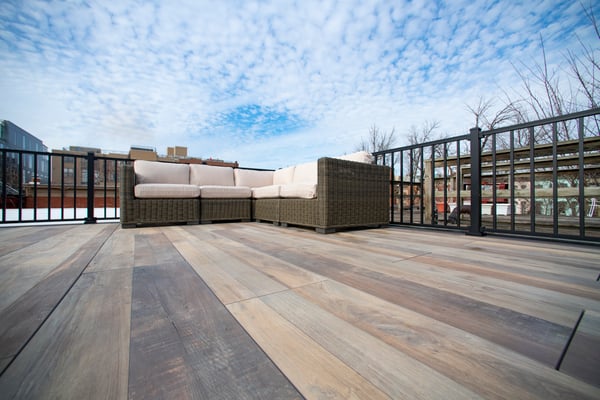We are getting a lot of requests for rooftop decks in Washington DC. So we thought we would update a blog on what to keep in mind when considering such a project.
Rooftop decks are becoming increasingly popular in the Washington, DC, area, and it’s easy to see why. A rooftop deck can provide lovely views, as well as a private, secluded area in your home to relax and to get away from the hustle and bustle of the city. If you’re thinking about adding one of these structures to your home, here are five things you should keep in mind before you get too far in the planning process.
#1: Avoid PVC Products for Your Rooftop Deck
Throughout the course of a year, rooftop decks are directly exposed to lots of extreme weather in the Washington, DC, area. That includes everything from ice and cold to intense sun. For this reason, some PVC decking brands actually suggest not using them on a rooftop structure. The extra heat and exposure can soften the PVC and create problems down the line.
What do professional build firms recommend then? Many say to consider a more durable product, such as tile, that won’t be susceptible to structural changes, even when exposed to extreme heat or cold.
As a general rule, if you’re interested in a particular material for your rooftop deck, always check with your contractor to determine whether you’re likely to experience any expansion, shrinking, or warping after prolonged weather exposure.
.jpg?width=300&name=rooftop%20deck%20baltimore%20bab%20(4).jpg)
#2: Pick a Rooftop Material That Won’t Get Too Hot
With a rooftop deck, every structural and material-related choice must address the unique challenges presented by the project. With direct sun exposure—especially during brutally hot Washington, DC, summers—opt for a material that won’t get too hot to the touch.
Some woods and synthetic materials can become uncomfortably warm in direct heat, and if you’re looking to walk barefoot on your rooftop deck, you’ll definitely want a material that stays a comfortable temperature. This is especially true for anyone with kids or pets, both of which can be more sensitive to overly hot decking.
One of the products we use now is Archatrak Porcelain Pavers. Archatrak offers a great alternative to wood or composite decking, and is available in many colors and styles.
Again, a material like tile will stay much cooler than natural wood or some other synthetic materials. Keep in mind, however, that color is also going to directly affect heat retention of any decking material, so stick with neutral or light colors to minimize this issue.
.jpg?width=300&name=logans-circle-archatrak-porcelain-deck-tiles-detail%20(3).jpg)
#3: Take Advantage of LEED Credits
If you’re undertaking a larger construction project, some materials can actually earn you LEED credits. (LEED stands for “leadership in energy and environmental design.”) By choosing a product that’s light or neutral in color, reflects sunlight, and keeps heat off the roof, you can potentially qualify for these LEED credits, as well as contribute to a more sustainable and environmentally friendly build.
Talk to your build firm for more information about the benefits of LEED credits and what types of material are most conducive to minimizing heat absorption..jpg?width=300&name=logans-circle-rooftop-deck-with-archatrak-deck-tiles%20(1).jpg)
#4: Consider All Decking Material Options, Not Just Wood
When it comes to rooftop deck materials, many people immediately think of wood because that’s such a ubiquitous option for ground-level decks. With rooftop decks, however, many professional build firms recommend a hardier material, such as tile. With tile, you don’t have to worry about scratches or blemishes, and you won’t experience any sagging between the joists, as you sometimes get with wood.
Many tile decks are installed using a pedestal system, wherein it’s quick and easy to replace out any one tile, if it does sustain damage or crack. Simply ordering a few extra tiles can give you peace of mind that your deck will look pristine for years to come.
Tile is also an aesthetically interesting installation. Depending on the style, color, and pattern you choose, it can be a much more modern, sleek, and contemporary design choice than natural wood or synthetic material made to mimic wood.
#5: Consider Roof and Substructure Access
Perhaps the most important thing to consider with a rooftop deck is that you absolutely still want access to your roof and decking substructure. A roof will typically have to be replaced every twenty years, and if you put down a permanent decking structure on top, redoing the roof will also entail tearing off that deck, redoing the roof, and then putting down a brand-new deck. This process can take a significant amount of time and money.
If you want to avoid having to replace both the roof and deck together, consider a more semipermanent decking solution. This can include a tile deck using a pedestal system, wherein each tile is screwed to an individual pedestal and locked into place with a fastening mechanism. With this kind of system, you can simply pull the tiles up when the roof needs to be done and put them back when the construction work is complete. This takes about three to four days of labor rather than the time necessary to construct an entirely brand-new deck after the roof repair or replacement.
As rooftop decks become more and more common in the Washington, DC, area, professional build firms are encountering an increasing number of questions from homeowners about the logistics of these projects. If you’re currently considering installing one in your home, one thing is clear: rooftop decks, especially those in the Washington, DC, area, require a different set of considerations than ground-level decks. Keep these five pointers in mind as you’re in the early planning stages, and don’t forget to lean on the expertise and experience of your build firm to get the structure that best suits your personal aesthetic, budget, and lifestyle.




